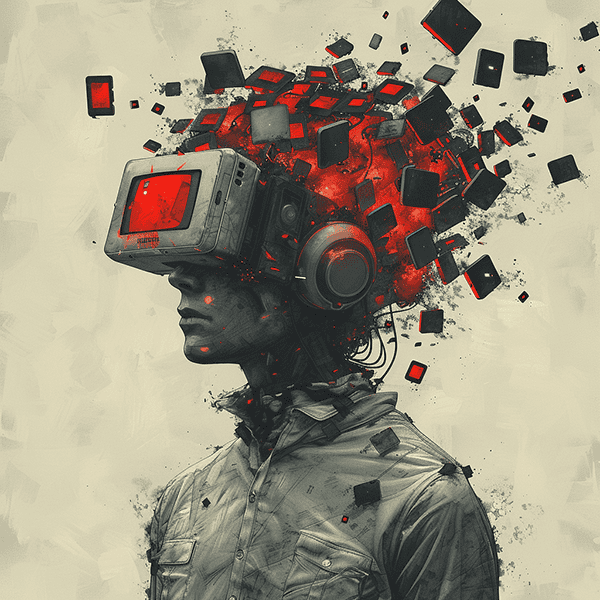Technology addiction, also known as digital addiction or internet addiction, is a growing concern in our increasingly connected world. But what is technology addiction exactly? At its core, technology addiction is a behavioral addiction characterized by an uncontrollable urge to use technological devices or engage with digital content despite harmful consequences on one’s physical, mental, and social well-being.
In today’s digital age, where smartphones, computers, and the internet are integral parts of our daily lives, the line between normal use and addiction can often blur. Technology addiction goes beyond merely spending a lot of time online or using devices frequently. It involves a compulsive need to engage with technology, often at the expense of other essential life activities and relationships.
It’s crucial to recognize that this issue affects people of all ages, but can be particularly impactful for young adults who have grown up in a world dominated by digital technology. The pervasive nature of technology in our society makes this form of addiction both widespread and challenging to address.

Signs and Symptoms of Technology Addiction
Recognizing the signs and symptoms of technology addiction is crucial in understanding the impact of technology addiction. These indicators can be categorized into behavioral, emotional, and physical symptoms.
A. Behavioral Indicators
- Loss of Control: Inability to limit time spent on devices or online activities.
- Prioritization of Technology: Choosing technology use over other important activities or responsibilities.
- Continued Use Despite Consequences: Persistent technology use even when it causes problems in relationships, work, or school.
- Secrecy or Dishonesty: Lying about or hiding the extent of technology use from others.
- Failed Attempts to Cut Back: Unsuccessful efforts to reduce or control technology use.
B. Emotional Symptoms
- Mood Changes: Irritability, anxiety, or depression when unable to use technology.
- Preoccupation: Constant thoughts about technology or online activities when not engaged with them.
- Guilt: Feelings of remorse or shame about the amount of time spent on devices.
- Loss of Interest: Decreased enjoyment in previously pleasurable activities that don’t involve technology.
- Use for Emotional Coping: Relying on technology to alleviate negative emotions or escape from problems.
C. Physical Symptoms
- Sleep Disturbances: Altered sleep patterns due to late-night technology use or difficulty sleeping without checking devices.
- Physical Discomfort: Eye strain, headaches, neck or back pain from prolonged device use.
- Carpal Tunnel Syndrome: Wrist and hand pain from excessive typing or gaming.
- Poor Personal Hygiene: Neglecting personal care due to being engrossed in technology use.
- Changes in Eating Habits: Skipping meals or overeating while using technology.
Understanding these signs and symptoms is crucial in identifying what technology addiction is and how it affects individuals. It’s important to note that the presence of one or two of these symptoms doesn’t necessarily indicate addiction. However, if multiple symptoms are present and they significantly impact daily life, it may be time to seek professional help or support.
Types of Technology Addiction
Understanding what technology addiction is involves recognizing its various forms. While technology addiction can manifest in numerous ways, here are some of the most common types:
A. Social Media Addiction
Social media addiction is characterized by an overwhelming urge to check and engage with social networking platforms. Individuals with this type of tech addiction may:
- Constantly refresh their feeds
- Feel anxious when unable to access social media
- Base their self-worth on likes, comments, and followers
- Neglect real-life relationships in favor of online interactions

B. Gaming Addiction
Gaming addiction involves compulsive engagement with video games, whether on consoles, computers, or mobile devices. Signs include:
- Playing for extended periods, often losing track of time
- Prioritizing gaming over work, school, or social obligations
- Experiencing withdrawal symptoms when unable to play
- Using gaming as an escape from real-life problems
C. Smartphone Addiction
This form of tech addiction centers around excessive and compulsive use of smartphones. Individuals might:
- Feel panic or anxiety when separated from their phone
- Constantly check their phone, even in inappropriate situations
- Experience phantom vibrations
- Use their phone to avoid face-to-face interactions


D. Internet Addiction
Internet addiction is a broader category that can encompass various online activities. It’s characterized by:
- Spending excessive time online for non-work-related activities
- Difficulty controlling internet use
- Neglecting offline relationships and activities
- Using the internet as a primary source of comfort or stimulation
Causes of Technology Addiction
To fully grasp what tech addiction is, it’s crucial to understand its underlying causes. The development of technology addiction is often multifaceted, involving a combination of psychological, neurological, and social factors.
A. Psychological Factors
- Escapism: Technology can provide a temporary escape from real-world problems, stress, or negative emotions.
- Low Self-esteem: Online environments may offer a sense of control or accomplishment that’s lacking in real life.
- Anxiety or Depression: Technology use can become a coping mechanism for underlying mental health issues.
- Impulse Control Issues: Difficulty in self-regulation can contribute to addictive behaviors.
B. Neurological Factors
- Dopamine Release: Engaging with technology, especially social media and games, can trigger the release of dopamine, the brain’s “feel-good” neurotransmitter.
- Brain Structure Changes: Prolonged technology use can alter brain structure, particularly in areas related to decision-making and impulse control.
- Reward System Hijacking: Technology can exploit the brain’s reward system, creating a cycle of craving and satisfaction.
C. Social and Environmental Influences
- Social Pressure: The fear of missing out (FOMO) and the need to stay connected can drive excessive technology use.
- Accessibility: The ubiquity and constant availability of technology make it easy to develop addictive behaviors.
- Cultural Norms: In a society where constant connectivity is often expected, it can be challenging to maintain healthy boundaries with technology.
- Family Dynamics: Lack of parental guidance or modeling of healthy technology use can contribute to addiction in young adults.
Understanding these causes is crucial in addressing technology addiction and how it develops. It’s important to note that tech addiction, like other behavioral addictions, often stems from a complex interplay of these factors rather than a single cause.
By recognizing the various types of technology addiction and understanding its root causes, individuals, families, and professionals can better approach prevention, intervention, and treatment strategies. This knowledge is particularly crucial for young adults who may be more susceptible to tech addiction due to their developmental stage and the prominent role of technology in their lives.
Impact of Technology Addiction
Understanding what technology addiction is involves recognizing its wide-ranging impacts on an individual’s life. The consequences of technology addiction can be profound, affecting mental health, physical well-being, social relationships, and professional or academic performance. For young adults, tech addiction can lead to failure to launch syndrome.
A. Mental Health Consequences
- Depression and Anxiety: Excessive technology use can contribute to or exacerbate feelings of depression and anxiety.
- Attention Deficits: Constant digital stimulation may lead to difficulties in focusing and maintaining attention in offline settings.
- Sleep Disorders: The blue light from screens and late-night usage can disrupt sleep patterns, leading to insomnia or other sleep-related issues.
- Cognitive Changes: Heavy technology use may impact memory, decision-making abilities, and cognitive flexibility.
B. Physical Health Effects
- Sedentary Lifestyle: Prolonged screen time often leads to decreased physical activity, potentially resulting in obesity and related health issues.
- Musculoskeletal Problems: Poor posture from device use can cause neck, back, and wrist pain.
- Vision Issues: Extended screen time may lead to digital eye strain, dry eyes, and potentially long-term vision problems.
- Carpal Tunnel Syndrome: Repetitive motions from typing or gaming can cause this painful wrist condition.
C. Social and Relationship Issues
- Social Isolation: Preferring online interactions over face-to-face connections can lead to real-world social isolation.
- Relationship Strain: Excessive technology use can negatively impact relationships with family, friends, and romantic partners.
- Communication Skills: Over-reliance on digital communication may hinder the development of in-person social skills.
- Empathy Reduction: Some studies suggest that excessive screen time may reduce empathy and emotional intelligence.
D. Academic or Professional Performance Decline
- Reduced Productivity: Constant distractions from technology can significantly decrease work or study efficiency.
- Poor Time Management: Difficulty in controlling technology use often leads to procrastination and missed deadlines.
- Decreased Learning Capacity: Overuse of technology may impact the ability to engage deeply with academic material.
- Career Implications: In severe cases, technology addiction can lead to job loss or academic failure.
Technology Addiction in Young Adults
When exploring what technology addiction is, it’s crucial to consider its particular impact on young adults, as this demographic is often most affected by and vulnerable to technology addiction.
A. Prevalence among Young Adults
- Digital Natives: Young adults have grown up with technology, making it an integral part of their lives and potentially increasing addiction risk.
- High Usage Rates: Studies consistently show that young adults have the highest rates of smartphone and social media use across all age groups.
- Normalization: Excessive technology use is often normalized among peer groups, making it harder to recognize problematic behavior.
B. Unique Challenges for this Age Group
- Identity Formation: Technology addiction can interfere with the crucial process of identity development in young adulthood.
- Career Development: Excessive technology use may hinder the acquisition of essential professional skills and networking abilities.
- Relationships: Technology addiction can impact the formation and maintenance of meaningful romantic and platonic relationships.
- Financial Independence: Addiction-related productivity issues can affect job performance and financial stability.
C. How Technology Addiction Relates to Failure to Launch Syndrome
Understanding what technology addiction is becomes particularly relevant when considering its relationship to “failure to launch” syndrome in young adults:
- Avoidance Mechanism: Technology can become a way to avoid the challenges and responsibilities of adult life.
- Skill Deficit: Excessive technology use may prevent the development of crucial life skills needed for independence.
- Delayed Milestones: Tech addiction can contribute to delays in achieving traditional adult milestones like moving out, starting a career, or forming long-term relationships.
- Exacerbation of Existing Issues: For young adults already struggling with transitions, technology addiction can compound difficulties in achieving independence.
- Social Comparison: Constant exposure to curated lives on social media can lead to unrealistic expectations and decreased self-esteem, further hindering progress toward independence.
At The Arise Society, we recognize the intricate relationship between tech addiction and the challenges young adults face in transitioning to independent adulthood. Our programs are designed to address these interconnected issues, providing support and strategies to overcome technology addiction while fostering the skills and confidence needed for successful adult life.
By understanding what tech addiction is and its specific impacts on young adults, we can better address this growing concern and support individuals in developing healthier relationships with technology while pursuing fulfilling, independent lives.
Diagnosis and Assessment of Technology Addiction
Understanding what technology addiction is involves recognizing how it’s diagnosed and assessed. While technology addiction is not currently recognized as a formal disorder in the Diagnostic and Statistical Manual of Mental Disorders (DSM-5), mental health professionals use various criteria and tools to identify problematic technology use.
A. Diagnostic Criteria
When determining what technology addiction is in a clinical context, professionals often look for signs similar to those of other behavioral addictions:
- Salience: Technology use dominates thoughts and behaviors.
- Mood Modification: Technology is used to alleviate negative emotions or achieve a “high.”
- Tolerance: Increasing amounts of technology use are needed to achieve the same effects.
- Withdrawal: Negative physical and emotional responses when technology use is reduced or stopped.
- Conflict: Technology use causes problems in relationships, work, or other areas of life.
- Relapse: Failed attempts to cut back on technology use.
B. Self-Assessment Tools
Several self-assessment questionnaires have been developed to help individuals understand their relationship with technology:
- Internet Addiction Test (IAT): A 20-item scale that measures the presence and severity of internet dependency.
- Smartphone Addiction Scale (SAS): Assesses problematic smartphone use across various dimensions.
- Social Media Addiction Scale (SMAS): Focuses specifically on addictive behaviors related to social media use.
- Gaming Addiction Scale (GAS): Measures addiction-like symptoms in the context of video game playing.
These tools can provide insights into what technology addiction is on a personal level, but should not be used as a substitute for professional diagnosis.
C. Professional Evaluation
A comprehensive professional evaluation is crucial in fully understanding what tech addiction is for an individual:
- Clinical Interview: A mental health professional will conduct a detailed interview to understand the person’s technology use patterns and their impact on daily life.
- Behavioral Observations: Sometimes, observing the individual’s interactions with technology can provide valuable insights.
- Psychological Assessment: Additional tests may be used to assess for co-occurring mental health issues like anxiety or depression.
- Physical Examination: A medical check-up may be recommended to rule out physical health issues related to excessive technology use.
Treatment and Management Strategies for Technology Addiction
Addressing what technology addiction is also involves understanding how it can be treated and managed. Treatment approaches often combine behavioral interventions, therapy, and lifestyle changes.
A. Digital Detox and Moderation Techniques
- Gradual Reduction: Slowly decreasing technology use over time to avoid withdrawal symptoms.
- Tech-Free Times: Designating specific periods of the day as technology-free.
- App Blockers: Using software to limit access to problematic apps or websites.
- Device-Free Zones: Creating spaces in the home where technology use is not allowed.
B. Cognitive Behavioral Therapy (CBT)
CBT is often effective in treating tech addiction by:
- Identifying Triggers: Recognizing what prompts excessive technology use.
- Challenging Thoughts: Addressing negative thought patterns that fuel addictive behaviors.
- Developing Coping Strategies: Learning healthier ways to manage stress and emotions.
- Setting Goals: Establishing and working towards realistic objectives for technology use.
C. Support Groups and Peer Support
- Technology Addiction Support Groups: Joining groups (online or in-person) where individuals share experiences and strategies.
- Peer Mentoring: Connecting with others who have successfully managed their technology use.
- Family Therapy: Involving family members in the treatment process to create a supportive environment.
D. Lifestyle Changes and Alternative Activities
- Physical Exercise: Engaging in regular physical activity as a healthy alternative to technology use.
- Mindfulness and Meditation: Practicing techniques to increase present-moment awareness and reduce the urge to use technology.
- Hobbies and Interests: Developing offline interests and activities to fill time previously spent on technology.
- Social Connections: Fostering in-person relationships and social activities.
At The Arise Society, we incorporate these treatment strategies into our comprehensive program for young adults. We understand that addressing tech addiction requires a holistic approach that manages technology use and supports overall personal growth and independence.
Our approach combines individual therapy, group support, and practical life skills training to help young adults overcome technology addiction and develop the tools they need for a balanced, fulfilling adult life. We recognize that each individual’s experience with technology addiction is unique, and we tailor our interventions to meet the specific needs of each participant in our program.
By understanding tech addiction, how it’s diagnosed, and the various treatment options available, individuals and their families can take informed steps towards healthier technology use and improved overall well-being.
Prevention of Technology Addiction
Understanding what technology addiction is also involves knowing how to prevent it. Prevention strategies are crucial, especially for young adults at higher risk of developing problematic technology use patterns.
A. Healthy Technology Habits
- Set Clear Boundaries: Establish specific times for technology use and stick to them.
- Practice Digital Mindfulness: Be aware of how and why you use technology at any moment.
- Implement the 20-20-20 Rule: Every 20 minutes, take a 20-second break and look at something 20 feet away to reduce eye strain.
- Use Technology Purposefully: Prioritize productive and meaningful technology use over mindless scrolling.
B. Parental Guidance and Education
While our focus is on young adults, parental involvement can play a crucial role in preventing technology addiction:
- Model Healthy Behavior: Parents should demonstrate balanced technology use.
- Open Communication: Encourage discussions about online experiences and potential risks.
- Set Family Rules: Establish and enforce family guidelines for technology use.
- Encourage Offline Activities: Promote engagement in sports, hobbies, and face-to-face social interactions.
C. Awareness and Digital Literacy Programs
- Educational Initiatives: Implement programs in schools and communities to teach about responsible technology use.
- Critical Thinking Skills: Develop the ability to evaluate online content and recognize manipulative design in apps and games.
- Time Management Workshops: Offer training on balancing technology use with other life activities.
- Stress Management Techniques: Teach healthy ways to cope with stress that don’t rely on technology.
The Arise Society’s Approach to Technology Addiction
At The Arise Society, we recognize that understanding what technology addiction is forms the foundation for effective intervention and support. Our approach to addressing technology addiction in young adults is comprehensive, personalized, and focused on long-term success.
How We Address Technology Addiction in Our Program
- Individualized Assessment: We conduct thorough evaluations to understand each participant’s unique relationship with technology.
- Integrated Treatment Plan: Our plans address tech addiction alongside other challenges young adults may face, such as anxiety, depression, or failure to launch syndrome.
- Skill Building: We focus on developing essential life skills that promote independence and reduce reliance on technology.
- Structured Environment: Our program provides a supportive setting that encourages healthy technology habits and fosters real-world connections.
The Arise Society is an immersive program based on observation and connection. Read this article by Dr. Vaughn Health, P.H D for a more in-depth understanding of our the program works.
https://thearisesociety.com/immersive-program/
At The Arise Society, we believe that by thoroughly understanding what tech addiction is, we can provide the most effective support for young adults struggling with this issue. Our goal is not just to address the addiction itself, but to empower young adults to build fulfilling, independent lives where technology is a tool, not a crutch.
We strive to create an environment where young adults can disconnect from their devices and reconnect with themselves, their goals, and their potential. Through our comprehensive approach, we help participants navigate the challenges of the digital age while developing the skills and confidence needed for success in all areas of life.

Conclusion – What is Technology Addiction?
As we’ve explored throughout this article, understanding what technology addiction is involves recognizing it as a complex and multifaceted issue that affects individuals, particularly young adults, in profound ways. Technology addiction is more than just excessive use of digital devices or the internet; it’s a behavioral pattern that significantly impacts mental health, physical well-being, social relationships, and overall quality of life.
To recap, tech addiction is characterized by:
- An uncontrollable urge to use technology
- Continued use despite negative consequences
- Withdrawal symptoms when technology use is limited
- Neglect of other important life areas
What technology addiction is not is simply spending a lot of time online or using devices frequently. The key distinction lies in the compulsive nature of the behavior and its detrimental effects on various aspects of life.
As we navigate an increasingly digital world, it’s crucial to maintain a balanced relationship with technology. This means being mindful of our tech habits, setting healthy boundaries, and prioritizing real-world experiences and relationships. For young adults, who are particularly vulnerable to technology addiction, developing these skills is essential for a successful transition to independent adulthood.
At The Arise Society, we recognize the challenges that technology addiction presents, especially when combined with other issues like failure to launch syndrome. Our approach emphasizes not just understanding what technology addiction is, but also providing comprehensive support to overcome it. We believe in empowering young adults to harness the benefits of technology while avoiding its pitfalls, ultimately helping them build fulfilling, independent lives.
Remember, if you or a loved one is struggling with technology addiction, help is available. Whether through professional treatment programs like those offered at The Arise Society, therapy, support groups, or self-help strategies, there are many paths to regaining control over technology use and improving overall well-being.
As we move forward in this digital age, let’s strive for a future where we master technology, rather than letting it master us. With awareness, support, and the right strategies, it’s possible to enjoy the benefits of our digital world while maintaining the rich, fulfilling offline experiences that make life truly meaningful.
